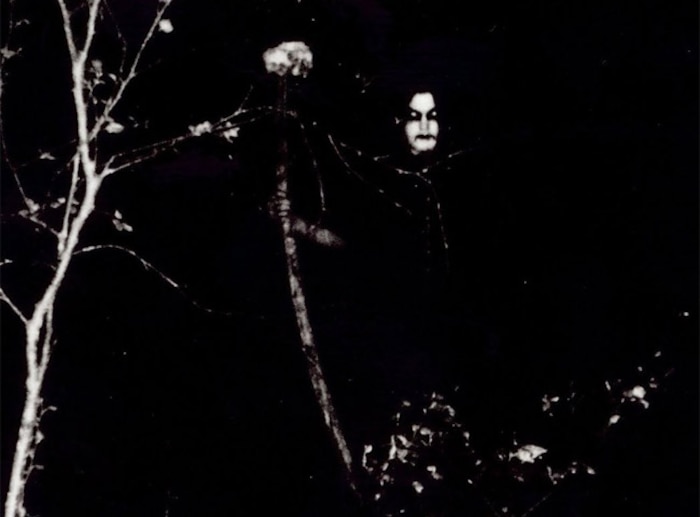Egyptrixx’s Black Metal for Dummies

As a producer, Toronto’s Dave Psutka – better known as Egyptrixx – throws techno, shoegaze and abstract bass in a cauldron, producing thick swathes of mystical fog that blur the portal between the dancefloor and the sensory deprivation chamber. You’ll likely know his work for UK label Night Slugs – whose Bok Bok and L-Vis 1990 will be DJing at the Academy in New York next month. But you may not know Language, the September 2012 album from his post-rock duo Hiawatha.
Either way, both types of music are done up in layer upon billowing layer of grey, purple and black, hinting at what has become a creeping obsession with the bleaker side of techno and the darkest corners of metal. These proclivities spill over into his production work as well, which you can hear this summer on the Bestial Mouths album, along with a new Egyptrixx album (coming soon). We found Dave “dead on the inside” after a long album mixdown session, and he bestowed upon us a black metal starter kit for the uninitiated.

Most movements in popular music have followed a similar arc from inception to commercial viability, starting out raw and original then gradually progressing to become tidier and more refined. Metal is no different, and a reasonably good way to introduce black metal is as a counterpoint to the commercialization of heavy metal in the late ’80s and early ’90s. As metal bands like Metallica and Iron Maiden went mainstream and started making glossy, high-production records and putting on big-budget stadium shows, black metal stayed underground.
Early black metal records were grim and atmospheric, exploring dark themes like self-mutilation, heritage and the occult while rejecting formal trends toward better production and pop song structure. The music was also notably avant-garde, and early bands like Emperor and Mayhem incorporated synthesizers and electronic music into their sound palette. (Famously, Mayhem featured an intro by German experimental electronic composer Conrad Schnitzler of Tangerine Dream on their Deathcrush EP.)
Basically, black metal is powerful music that I've been listening to and loving for a while. Since the early days in Britain and Scandinavia, it has been through lots of revisions and interpretations. Typically, it’s separated into three distinct periods; the so-called First, Second and Third Waves. There is a lot of great music in all three. Here are some recommendations to get you started. Enjoy.
FIRST WAVE (EARLY 1980S, UK & SCANDINAVIA)
Venom “Black Metal” (Black Metal, 1982)
A lot of people consider Venom’s Black Metal to be one of the genre’s first albums. Most of this “first wave” of bands were considered speed or thrash metal and created a prototype of the sound by adjusting their music to be “colder” sounding, more repetitive and more extreme.
Further First Wave listening: Celtic Frost, Bathory, Hellhammer
SECOND WAVE (EARLY 1990S, NORWAY)
Mayhem “Deathcrush” (Deathcrush, 1987)
Many consider Deathcrush to be the essential Norwegian black metal record. Though it was released in 1987, it’s an inspiration to – and a great example of – Second Wave’s extreme musical ideologies. It has achieved a certain timelessness or “anthem” status. I play this at dance parties sometimes if I'm not having fun.
Darkthrone “Natassja In Eternal Sleep” (Under a Funeral Moon, 1993)
This is the first track off of Darkthrone’s second album and a Second Wave classic. Their first three albums are considered by many to have best articulated the black metal sound, and they’re all great. Darkthrone was the first black metal band I really got into.
Further Second Wave listening: Immortal, Satyricon, Burzum, Emperor
THIRD WAVE (LATE 1990S - PRESENT, EUROPE & USA)
Krallice “Boat Driver” (Orphan of Sickness, 2011)
NYC-based Krallice is, at its core, a collaboration between avant-garde guitarists Mick Barr and Colin Marston, and possibly one of the more musically advanced black metal bands. Their signature is extremely dense and layered melodies, and they are a good example of the creative reappropriation that, in my opinion, characterizes the Third Wave of black metal. All of their albums are great (especially 2012's Years Past Matter) but this track, off a 2011 EP of Orphan cover songs, is a personal favorite.
Leviathan “What Fresh Hell” (Tentacles of Whorror, 2004)
Leviathan is the solo project of California-based artist Wrest, AKA Jef Whitehead. He writes, performs and records all of his songs, has never performed live and is known for extremely personal, intimate records. Leviathan is a good example of a contrast of thematic scale that exists between the Second and Third Wave – many Second Wave bands dealt with big, somewhat abstract themes such as heritage and spirituality whereas a lot of the best Third Wave artists tend to be more introspective and personal.
Further Third Wave listening: Wolves in the Throne Room, Liturgy, Watain, Xasthur

